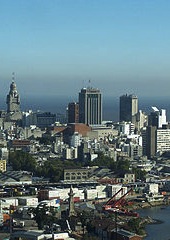Uruguay: South America’s New Zealand?
Will tiny Uruguay get squeezed between its two much larger neighbors, Brazil and Argentina, or prove itself resilient?
June 30, 2013

Uruguay is the classic small player who “punches above its weight.” It only has 3.3 million people and is dwarfed by its larger neighbors Brazil and Argentina, with 197 million and 41 million people, respectively.
But historically, it was a wealthy country.
According to Uruguay’s Deputy Economy Minister, Luis Porto, back in 1870, Uruguay — like Argentina and Australia — was one of the world’s richest economies.
This was largely thanks to its rich agricultural endowment.
For a small nation, it was not only rich, but also competitive, as became apparent on the world sporting stage. It won the inaugural FIFA Football World Cup in 1930.
Then Uruguay backed it up in 1950 in a shock 2:1 win over that year’s hotter-than-hot favorite host nation, Brazil, at the newly built Maracana Stadium in Rio de Janeiro.
That game was played in front of 200,000 people (mainly consisting of shocked Brazilians who have been haunted by the result ever since).
When Uruguay was wealthy, it was known as the “Switzerland of the southern hemisphere” In the modern context, the best comparison is probably with New Zealand.
New Zealand and Uruguay have a lot in common. Both are small countries dependent on agriculture, services and tourism and are also economically tied to the fortunes of their considerably larger neighbors.
While New Zealand has benefited from having “The Lucky Country,” Australia, as its main next-door neighbor, Uruguay has had Argentina.
Argentina’s woes are well documented — and Uruguay is strongly influenced by the boom-bust cycle of the Argentine economy in terms of trade flows.
But Uruguay also has Brazil next door, and the previously often erratic fortunes of their neighbor have been on the up over the past decade, especially when compared to poor performances in the 1980s and 1990s.
Uruguay, Brazil, Argentina, Paraguay and Venezuela make up the common market trade pact Mercosur.
It would be expected that Uruguay, like Chile, could benefit from being a small open economy opening up to other nations including its economically larger neighbors.
But unlike Chile, Uruguay can’t sign up to an FTA with another country without the permission of its Mercosur partners.
In fact, Uruguay finds itself almost squeezed by the new divide in Latin America.
The nations that have formed the Pacific alliance and look towards institutions like APEC — Mexico, Chile, Peru and Colombia — have largely supported free trade and open economies, even when the global financial crisis of 2008 was at its worst.
On the other hand, nations like Argentina, Venezuela and Bolivia have supported protectionist and populist policies, partly in response to the excesses of the IMF’s policies in the region (and elsewhere) during the 1990s.
The key question remains about the elephant in the room, Brazil, and which way it will lean.
When I was in Mexico, most Mexican economists and business representatives claimed Brazil was already going down the protectionist path, particularly when it comes to Mexican industrial products.
But the world is hoping Brazil will keep an open economy stance as it gains more economic weight on the global scale.
In any case, Uruguay may be keen to be seen as a “Pacific style” South American nation in terms of philosophy.
But with its geography tied down on the Atlantic side of the continent, wedged between Argentina and Brazil, many Uruguayan businesses are concerned that, despite the existence of Mercosur, most of their goods and services get tied up in red tape in both Brazil and Argentina.
In some ways, Uruguay is caught between its two large neighbors and finds it therefore difficult to shine. My own sense is that the country’s future is bright.
Uruguay may no longer be “the Switzerland of the southern hemisphere” as it was in 1870.
But being the New Zealand of South America in the 21st century may suit Uruguay just fine.
And it would underscore Uruguay’s commitment to openness, excellence, human capital development and occasionally being able to knock off larger players in football.
In short, count on Uruguay living up to its reputation as “el país corajudo” — the plucky country.
Takeaways
Uruguay may no longer be "the Switzerland of the southern hemisphere," as it was in 1870.
Being the New Zealand of South America is not a bad position to be in for Uruguay in the 21st century.
Uruguay finds itself straddling a new divide in Latin America, pitting Mercosur nations against each other.
It's Brazil, Argentina, Paraguay and Venezuela vs. Mexico, Chile, Peru and Colombia on trade.
Read previous

The End of Turkey’s Europeanization?
June 28, 2013
